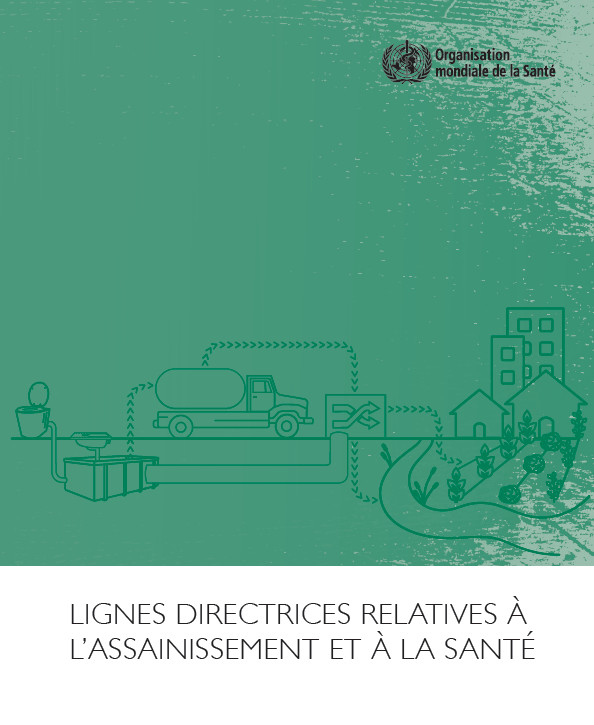Lignes directrices relatives à l'assainissement et à la santé
 |
Guidelines on sanitation and health
Guías para el saneamiento y la salud
دلائل توجيهية بشأن الاصحاح والصحة
guide Nov 2019 ; 220 pages
Ed. WHO - Genève ; Isbn: 978-92-4-251470-4
Téléchargeable sous format: PdF
Téléchargeable chez l'éditeur
Page de présentation d'un éditeur
Résumé:
Elaborées conformément aux processus énoncés dans le Manuel OMS pour l'élaboration des lignes directrices, celles-ci fournissent une vue d'ensemble pour obtenir un impact optimal sur la santé des mesures d'assainissement. . Elles présentent une synthèse de l'état des données probantes disponibles concernant les liens entre l'assainissement et la santé, formulent des recommandations fondées sur des données factuelles et proposent des orientations encourageant des politiques internationales, nationales et locales en matière d'assainissement. Les lignes directrices visent également à soutenir et à préciser le rôle des acteurs de la santé et autres entités dans la politique et la programmation pour l'assainissement afin de veiller à ce que les risques sanitaires soient identifiés et gérés efficacement.
Les lignes directrices s'adressent principalement aux autorités nationales et locales responsables de la sécurité des systèmes et des services d'assainissement, notamment les décideurs, les planificateurs, les responsables de l'élaboration, de la mise en œuvre et du suivi des normes et de la règlementation. Abstract:
Developed in accordance with the processes set out in the WHO Handbook for Guideline Development, these guidelines provide comprehensive advice on maximizing the health impact of sanitation interventions. The guidelines summarize the evidence on the links between sanitation and health, provide evidence-informed recommendations, and offer guidance for international, national and local sanitation policies and programme actions. The guidelines also articulate and support the role of health authorities in sanitation policy and programming to help ensure that health risks are identified and managed effectively.
The audience for the guidelines is national and local authorities responsible for the safety of sanitation systems and services, including policy makers, planners, implementers within and outside the health sector and those responsible for the development, implementation and monitoring of sanitation standards and regulations. Contents:
Chapter 1. Introduction 1
1.1 The significance of sanitation for human health 1
1.2 Sanitation as a human development issue 2
1.3 Scope 4
1.4 Objectives 6
1.5 Target audiences 7
1.6 Health authorities mandate 7
1.7 Methods 7
1.8 Guidelines structure 8
References 9
Chapter 2. Recommendations and good practice actions 11
2.1 Recommendations 11
2.2 Good practice actions 20
References 26
Chapter 3. Safe sanitation systems 29
3.1 Introduction 29
3.2 Toilets 31
3.3 Containment – storage/treatment 34
3.4 Conveyance 39
3.5 Treatment 44
3.6 End use/disposal 49
3.7 Applicability of sanitation systems 52
References 57
Chapter 4. Enabling safe sanitation service delivery 59
4.1 Introduction 59
4.2 Components of an implementation framework 59
4.3 Policy and planning 61
4.4 Legislation, regulations, standards and guidelines 64
4.5 Roles and responsibilities 68
4.6 Environmental health authorities and their role in sanitation 70
4.7 Delivering sanitation at local level 74
4.8 Developing sanitation services and business models 75
4.9 Fostering the sanitation services market 78
4.10 Management of special sanitation risks 79
References 83
Chapter 5. Sanitation behaviour change 84
5.1 Introduction 84
5.2 Institutional and government responsibilities for sanitation behaviour change 84
5.3 Sanitation behaviours and determinants 85
5.4 Changing behaviours 87
5.5 Monitoring and learning for success 95
References 97
Chapter 6. Excreta-related pathogens 100
6.1 Introduction 100
6.2 Microbial aspects linked to sanitation 102
6.3 Environmental transmission of pathogens in faecal waste 114
6.4 Treatment and control 120
References 122
Chapter 7. Methods 125
7.1 Introduction 125
7.2 Contributors 125
7.3 Scoping and question formulation 126
7.4 Evidence retrieval, assessment and synthesis 128
7.5 Evidence grading 128
7.6 Evidence-to-Decision (EtD) framework 130
References 132
Chapter 8. Evidence on the effectiveness and implementation of sanitation interventions 133
8.1 Introduction 133
8.2 Summary and discussion of evidence 133
8.3 Reviews of intervention effectiveness 134
8.4 Reviews of implementation 141
8.5 Summary of evidence reviews 142
References 150
Chapter 9. Research needs 151
9.1 Pursuing a sanitation research agenda 151
9.2 Research agenda 151
References 157
Annexes
Public-Cible:
Mots clefs: |
assainissement (CI) (DT) (OP) (ope) , santé (CI) (DT) (OP) (ope) |
Editeur/Diffuseur: |
|
WHO
-
World Health Organization - Genève - Suisse |
En cas de lien brisé, nous le mentionner à communication@pseau.org